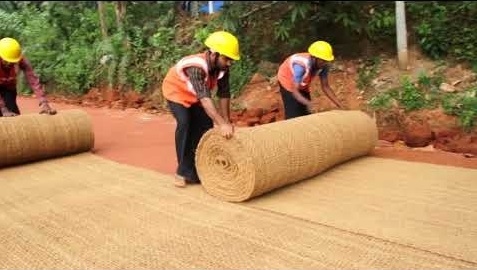
Coir geotextiles in roads – Roads are an integral part of our life. Paved roads are built for the comfort and convenience of the population. The main characteristics of paved roads and parking lots are their high initial costs, reliability, life expectancy and maintenance costs.
Coconut geotextile can be used for temporary soil stabilization in road or dam construction. Coconut geotextile is used as a separation drainage layer on the road. It is also intended to be used as a reinforcing material at the start of a project. Coconut geotextiles are widely used around the world in road construction, while the use of coconut geotextiles is very limited. Only very limited attempts to use coconut geotextiles in road construction.
In addition, Coir geotextiles can also be used as the first layer of pavement before asphalt to prevent the asphalt or road from cracking and cracking. In the future, coconut fiber can be increased to mitigate or reduce the risk of landslides. In areas prone to landslides, coconut grass can improve slope stability.
Improving Soft Soil Layers for Paving Purposes
Increased construction activity around the world puts great pressure on existing land for new and suitable sites, often indicating the need for improvements to improve existing sites deemed unsuitable for conventional foundations. This is achieved by soil improvement methods used to improve soil quality that is unsustainable in its natural state.
Among construction activities, a well-developed road network is a critical infrastructure requirement that plays a crucial role in moving quickly and comfortably between regions in countries like India. One of the innovative soil improvement methods practiced all over the world is the use of coconut geotextiles, which include geotextiles, geomembranes, geonets, etc.
Increase road durability with natural products | Coconut geotextiles on roads
The influence of coconut geotextiles on the bearing capacity is carried out during the slab load test. This helped to understand how geotextiles work as reinforcement for dirt roads and landfills. Different types of coconut geotextiles are described by the depth of laying in dry and wet conditions.
Use of Coir Geotextiles Proven to Increase Soil Strength
The results showed that the bearing capacity of coconut-reinforced soil increases regardless of the type of coconut geotextile and the saturation state. The tracking behavior of sections of unpaved unreinforced and coconut fiber-reinforced unpaved roads was compared using static model loading. The groove depth was significantly reduced by placing the coco geotextile between the subgrade and the subgrade.
Coconut road geotextiles have been shown to be very effective in reducing setting time due to radial drainage. Round drains of a triangular arrangement gave the maximum positive effect. In the long term, degradation of the coconut geotextile is expected, resulting in a soil fiber matrix.
Thus, the strength and compression properties of soil-coir fiber composites were carried out. Results showed that soil strength increased by 150-200% when mixed with 2% fiber approx. 12 mm length in all compression conditions. As a result, significant savings in substrate/bottom thickness are achieved when using coconut geotextiles, which saves a lot of natural aggregates.
Therefore, Coir is reviewing geotextiles to reinforce the track. This method should be encouraged immediately, so that road reinforcement does not happen often. And give companies the opportunity. So this is the Coir geotextile prevention solution that should be used on the streets. Coconut geotextiles withstand runoff rates that cause erosion and retain soil moisture.